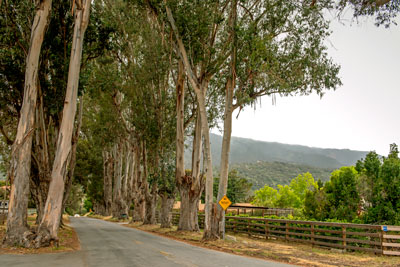National Register of Historic Places in Monterey County
Eucalyptus Tree Row
Carmel Valley Road & Boronda Road
Carmel Valley
Planted 1874-1881
The site consists of thirty-three Eucalyptus globulus trees with an average girth of twenty-two feet. The trees were planted at the beginning of an era in which statewide propagation of the species reached overwhelming popularity.
The most common Eucalyptus planted in California was the Eucalyptus globulus or Blue Gum, a species which can reach heights of 150-200 feet. Due to its enormous size when mature, plus the massive reach of its branches, the Blue Gum was promoted as a windbreak for large unprotected, wind-swept farmlands such as those in the Salinas Valley.
During the 1870s and 1880s, a period in which malaria was a major cause of illness in California, the aroma of Eucalyptus leaves was believed to provide health benefits. Growing Eucalyptus trees was thought to ward off malarial infections, purify the air, and relieve asthmatic symptoms. Eucalyptol, an essential oil derived from the leaves of numerous species of the tree, was, and still is, used in the manufacture of patent medicines. Because eucalyptus blossoms provided abundant nectar for bees, the trees were promoted for commercial honey production.
Source: NRHP nomination submitted in 2007
